How to backup & restore EFS / IMEI on Android phones using an easy steps guide. Similar to the partitions on your computer, the Android smartphone has partitions. One of them is an Encrypted File System i.e. EFS. It is related to the networking and communication within Android phones. Moreover, the EFS folder is located in the system directory of your phone and contains some important information about your phone’s IMEI, Wireless Product Code, System ID, and NV data.
Besides, EFS can handle all the functions related to connectivity including Cellular Networks, Wifi, Bluetooth, IMEI, Network Unlock Information, etc. Hence, for any reason, if this EFS data gets corrupted then your device will be completely useless and will no longer be recognized by your carrier. Also, you’ll be not able to make or receive calls, send or receive messages, or connect using Wifi, Bluetooth, etc. Your IMEI will become null. There are many reasons why your EFS data can get corrupted some of them are listed below:
- Installing custom ROMs from unknown sources may corrupt EFS data.
- Installing a corrupted Kernel or unsupported Kernel may also lead to the corruption of EFS data.
- In rare cases, manually upgrading or downgrading official firmware may also corrupt EFS data.
How to Backup and Restore EFS/IMEI on Android phones
To avoid any unpleasant situations mentioned above, it is necessary to take a complete backup of EFS data. Here, we’ll discuss some easy 10 methods on how to backup and restore EFS on Android phones.
Disclaimer
Try this at your own risk. We’ll not be held responsible if your phone gets damaged by following these methods.
Pre-Requisites
- Make sure your Android phone is charged at least up to 60%.
- Enable USB debugging mode from your mobile settings.
- Mobile USB drivers must be installed on your computer.
Method 1: Using EFS Professional Tool
At first, we’ll use EFS software on your Windows PC to backup IMEI. Let’s get straight into it.
Requirements
- Android phone with Root access (custom recovery not needed).
- Microsoft .NET Framework installed on your computer.
- EFS Professional tool.
- Busy Box App installed on the Phone.
Downloads
Steps to backup EFS
- Download and install the Busybox App on your phone.
- Launch it and grant Superuser permissions.
- On the main screen tap on the Install option.
- This will install the required files for BusyBox to work.
- After installation, you’ll see a successful message on the screen.
- Furthermore, connect your phone to the computer via a USB cable.
- Download and extract the EFS Professional tool on your PC.
- From the extracted folder, open the EFS Professional.exe file.

- Then click on EFS Professional from the popup window.
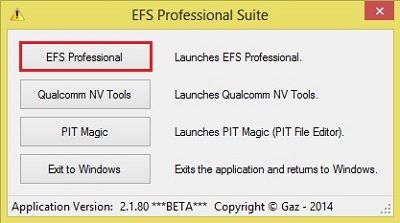
- Moreover, click OK on the next popup window.
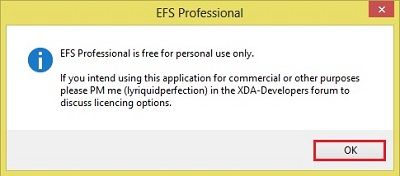
- This will launch the EFS Professional tool. It will automatically detect the connected phone.
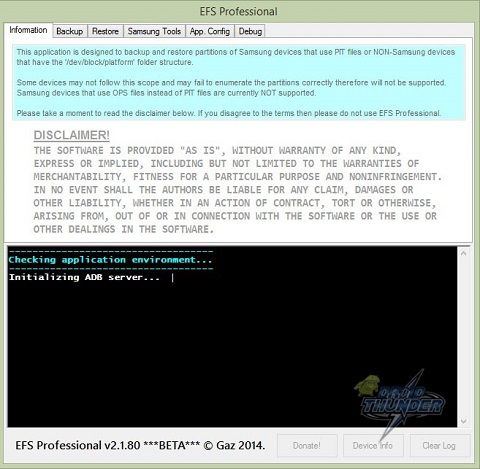
- At the same on your phone, a popup window will appear to grant Superuser permission. So grant it.
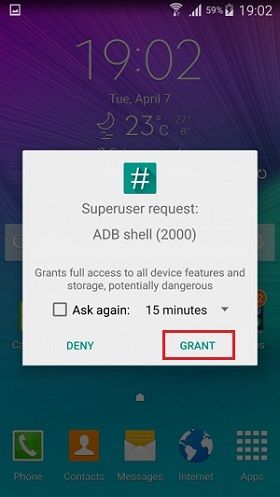
- After successful detection, you’ll see your device status, model number, firmware version, root and busy box version, etc.
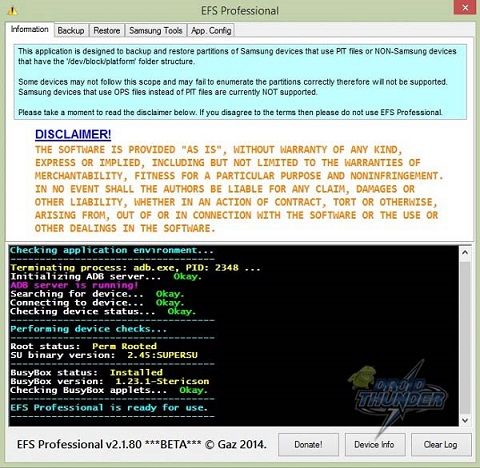
- If your computer fails to detect the device, make sure device drivers are properly installed or not.
- Now tap on the Backup tap located on the top left corner of the tool. Also, select the type of device under the Device filter option. I’m using the Samsung International variant phone so I’ll select Samsung Int. Variants. If your phone runs on the Qualcomm Snapdragon processor, then you need to select Samsung Int. LTE Variants.
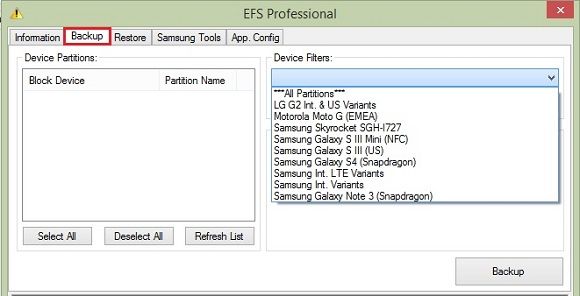
- Now just tap on the Backup option to start the process.
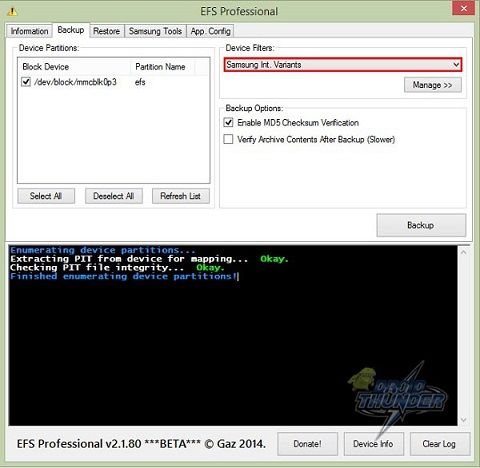
- After a minute, the backup process will complete with a successful message displaying on the screen.
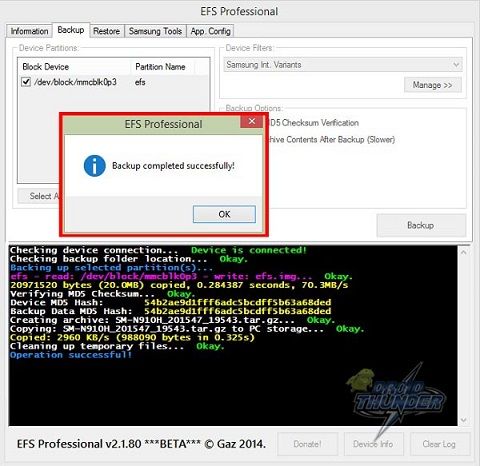
- The backed-up EFS file (.tar.gz) will be saved in the EFS Professional\EFSProBackup folder. The same file will also be saved in your phone’s internal storage under the EFSProBackup folder.

Steps to restore EFS
- In the EFS Professional tool, click on the Restore tab.
- From the drop-down menu in the Restore options, select the backed-up file.
- Click on the Restore option to initiate the process.
- Finally! You’ve successfully backed up and restored EFS data using the EFS Professional Tool. Now you can check your device IMEI number by typing *#06# on the phone’s dial pad.
Method 2: Using Terminal Emulator App
In this method, we’ll use an Android app to backup the IMEI number. Let’s start it!
Downloads
Steps to backup EFS
- Download and install the Terminal emulator app on your phone.
- Launch the App.
- Type this command in it and press enter:
su
- As soon as you hit enter, a window to grant superuser permissions will pop up. So allow it.
- On the next line type either of the two commands and press enter:
- To backup EFS on internal storage:
dd if=/dev/block/mmcblk0p3 of=/storage/sdcard/efs.img bs=4096
- To backup EFS on an external SD card:
dd if=/dev/block/mmcblk0p3 of=/storage/extSdCard/efs.img bs=4096
- This command will create an efs.img file on your phone’s internal/external storage. Copy this file on your computer for more safety.
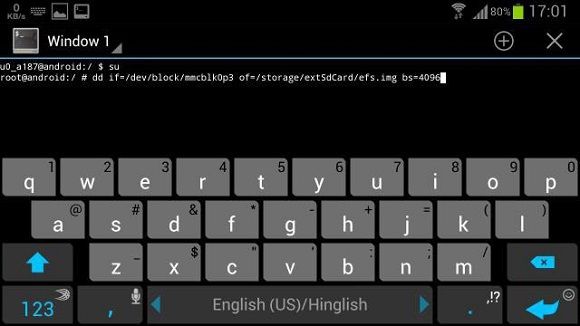
- All the commands are case sensitive so type each command line carefully.
Steps to restore EFS
- Launch the Terminal Emulator app and type these commands in it.
su
- On the next line, type either of these commands and press enter:
- To restore EFS on internal storage:
dd if=/storage/sdcard/efs.img of=/dev/block/mmcblk0p3 bs=4096
- To restore EFS on an external SD card:
dd if=/storage/extSdCard/efs.img of=/dev/block/mmcblk0p3 bs=4096
- If this Terminal Emulator method does not work for you, it might be due to the location of the EFS partition on your device.
- To fix this try these steps:
- Download and install the Root browser app on your phone.
- Launch it and go to the dev/block directory and note down the exact path of EFS data files.
- Now edit the file path in the command line accordingly:
dd if=/dev/block/mmcblk0p3 of=/storage/sdcard/efs.img bs=4096
- Finally! You’ve successfully backed up and restored EFS / IMEI using the Terminal Emulator app.
Method 3: Using Custom recovery
Here, we’ll use TWRP custom recovery to backup the IMEI number.
Requirements
- Rooted Android phone.
- Custom recovery like CWM / TWRP installed on your phone.
Steps to backup EFS
- Boot into TWRP custom recovery.
- Select the Backup option.
- Select the partitions including EFS to backup and swipe to start the backup process.
Steps to restore EFS
- It is similar to the backup process just click the Restore option and select a saved backup file.
- Finally! You’ve successfully backed up and restored EFS/IMEI using custom recovery.
Method 4: Using Script
Here, we’ll use a script file on your Windows PC to backup the IMEI number.
Downloads
Steps to backup EFS
- Download and extract the zip file on your computer.

- Connect your phone to the computer using a USB cable.
- On PC, open the Start.bat file from the extracted folder.
- A black window will appear on your screen.
- To backup EFS, type 1 and hit the enter key.
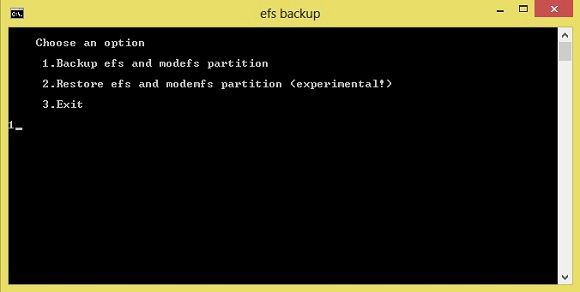
- On the next screen, type yes to start the backup process.
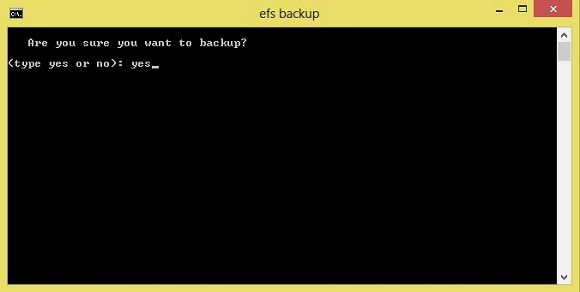
- The EFS backup file will be created in the EFS backup/backup folder.
Steps to restore EFS
- It is similar to the backup process just select the Restore option and then select the saved backup file.
- Finally! You’ve successfully backed up and restored EFS / IMEI using Script.
Method 5: Using Aroma Installer
In this method, we’ll use an aroma installer to backup the IMEI number.
Requirements
- Rooted Android device.
- Custom recovery like CWM/TWRP installed on your phone.
- Aroma Installer.
Downloads
Steps to backup EFS
- Download and copy the EFS_backup_Restore_Aroma.zip file on your phone.
- Do not extract it.
- Boot your phone into recovery mode.
- Select the Install Zip option.
- On the next screen, select the Choose zip from the SD card option.
- Navigate to the EFS_backup_Restore_Aroma.zip file and select it.
- Moreover, the next screen you will have is the Aroma installer.
- You may backup EFS on either internal or external storage. Here I’ll take backup on both the storage.
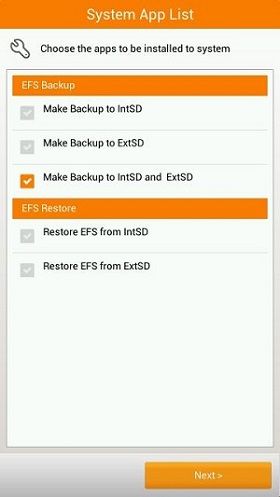
- Click the Next option to start the EFS backup process. It’ll take a minute to complete.
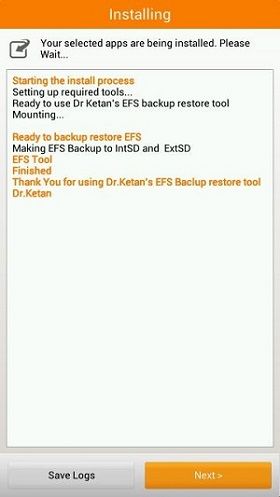
- Return to recovery mode and select the Reboot system now option to restart the phone.
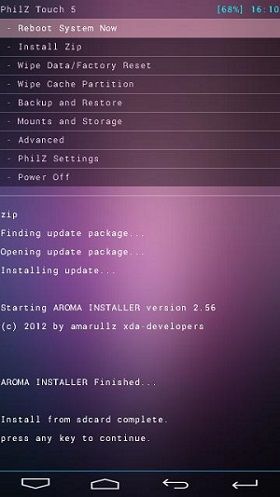
Steps to restore EFS
- It is similar to the backup process just select the Restore option from Aroma Installer and select the saved backup file.
- Finally! You’ve successfully backed up and restored EFS / IMEI using Aroma Installer.
Method 6: Using Samsung Tool
The Samsung Tool app is one of the easiest ways to take backup of an EFS partition. This app was developed by recognized developer Ricky Divjakovski from the XDA community.
Downloads
Steps to backup EFS
- Download and install the Samsung Tool app on your phone.
- Open it and click on the Backup EFS option.
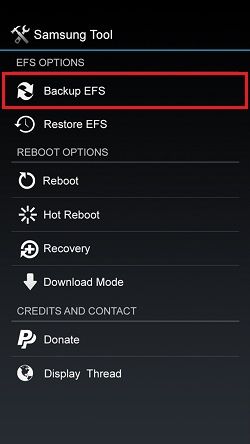
- Select the location of the backup process and click OK to start the EFS backup process.
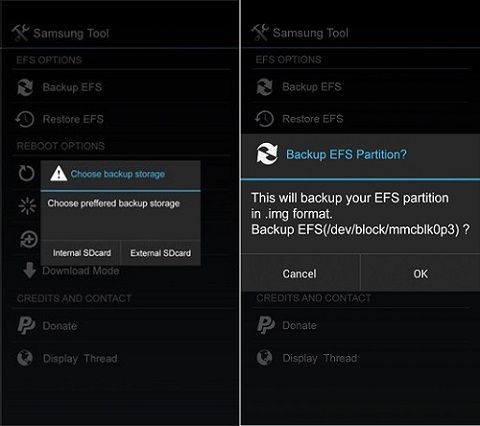
- This will create a backup of EFS in internal/external storage on your phone.
Steps to restore EFS
- It is similar to the backup process just select the Restore EFS option and then select the saved backup file.
- Finally! You’ve successfully backed up and restored EFS / IMEI using Samsung Tool.
Method 7: Using SA Manager App
Here, we’ll use an Android app called SA Manager to backup your IMEI number.
Downloads
Steps to backup EFS
- Download and install the SAManager App on your phone.
- Launch it and click on the EFS Manager option.
- Furthermore, on the next screen select the Backup EFS option.
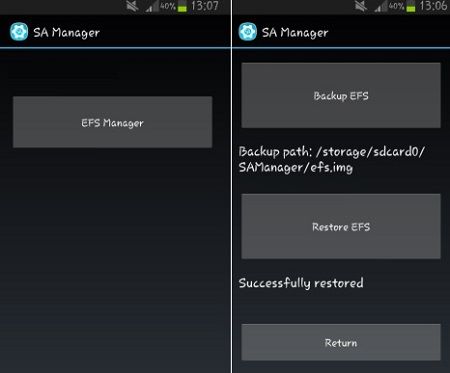
- This will start the EFS backup process.
Steps to restore EFS
- It is similar to the backup process just select the Restore option and then select the saved backup file.
- Finally! You’ve successfully backed up and restored EFS / IMEI using the SAManager App.
Method 8: Using Andromizer App
In this method, we’ll use the Andromizer application to backup your IMEI number. Let’s get straight into it.
Downloads
Steps to backup EFS
- Download and install the Andromizer App on your phone.
- Launch it. Then go to the Tools tab and select IMEI (efs) Backup/Restore option.
- Moreover, on the next screen select the Backup option to start the EFS backup process.
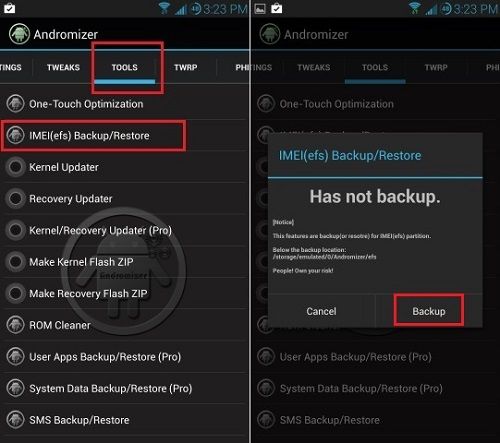
- This EFS backup file will be saved in the Andromizer folder.
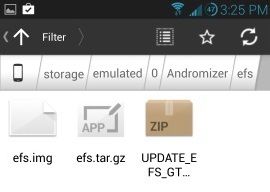
Steps to restore EFS
- It is similar to the backup process just select the Restore option and then select the saved backup file.
- Finally! You’ve successfully backed up and restored EFS / IMEI using the Andromizer App.
Method 9: Using Mobile Uncle App
Here, we’ll use an Android app called Mobile Uncle to backup your IMEI number.
Downloads
Steps to backup EFS
- Download and install the Mobile Uncle app on your phone.
- Launch it. Then click on the IMEI Backup Restore option.
- Furthermore, on the next screen select Backup IMEI to SD card option.
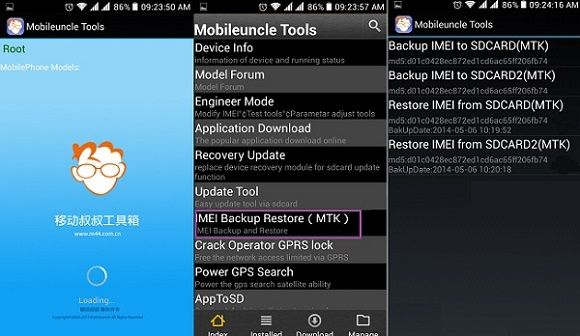
- This will start the EFS backup process.
Steps to restore EFS
- It is similar to the backup process just select the Restore option and then select the saved backup file.
- Finally! You’ve successfully backed up and restored EFS / IMEI using the Mobile Uncle App.
Method 10: Using Ktool
This is another handy tool to back up EFS / IMEI. This tool supports all Samsung phones except Qualcomm-based LTE devices.
Downloads
Steps to backup EFS
- Download and install the HC-KTool app on your phone.
- Launch it. Moreover, click on the Backup EFS option.
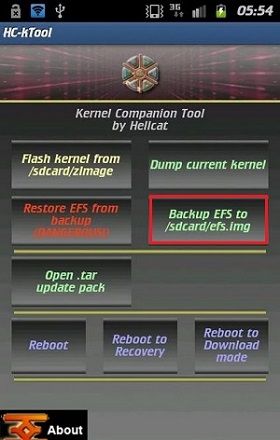
- This will start the EFS backup process.
- After completion of the process, you may run the EFS backup check.
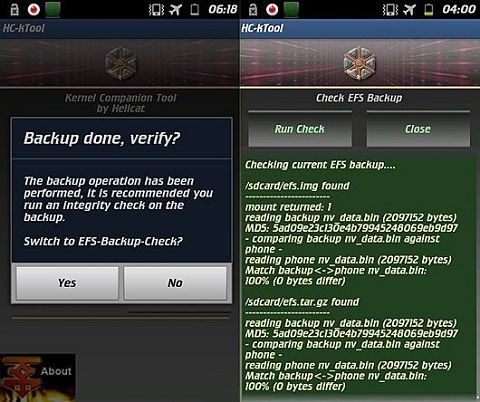
Steps to restore EFS
- Launch the app and select the Restore EFS option.
- Select the saved img/tar EFS file you want to restore.
- Finally! You’ve successfully backed up and restored EFS / IMEI using KTool.
Conclusion
Finally! This is how you can backup and restore EFS/IMEI data. If you come across any difficulty, then kindly comment below.
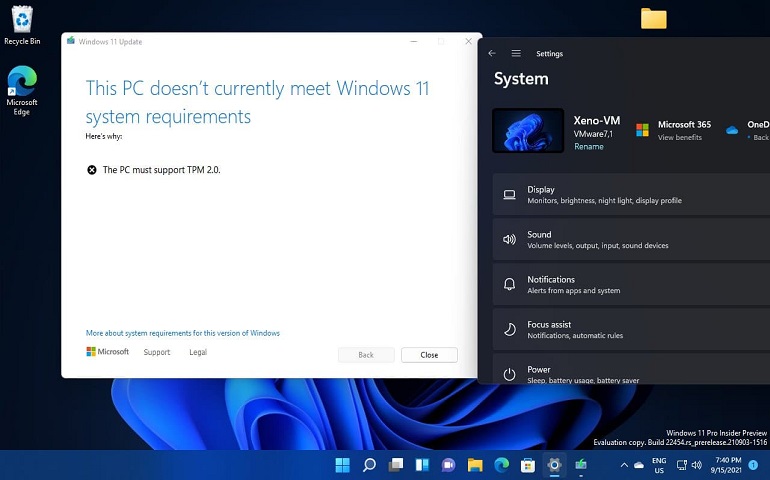

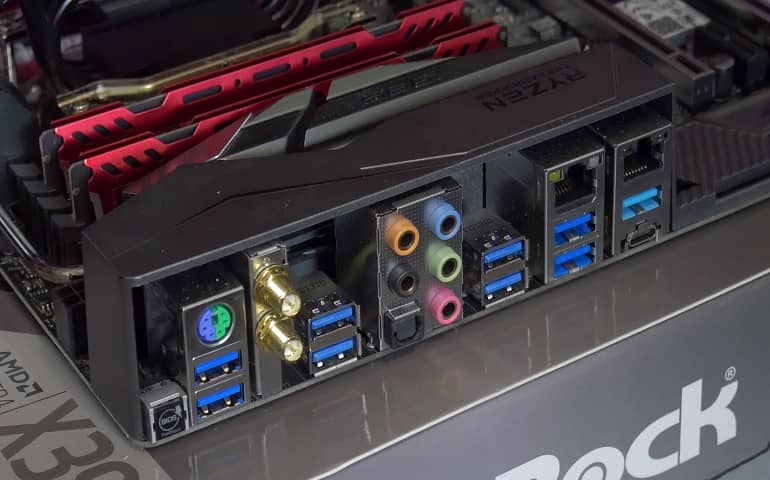



15 thoughts on “How to Backup and Restore EFS/IMEI on Android phones”
can I backup and restore my efs folder in my samsung galaxy y gt-S5360.
Yes
This worked like a charm! Thank you very much
Mr. Abhijeet, you are a genius. thank you bro
can i backup EFS alone by TWRP cuz in the method u said to back it up with all other files but if im using a custom rom and i just want to fix this and not go back to old rom cuz if i backup everything and restore it it’ll restore everything not only EFS
Yes you may just select the EFS partition to backup EFS alone..
Thank you very much 😀
How to Backup IMEI on Galaxy Ace S5830i ??
Galaxy Toolbox is not Restoring IMEI on a Custom rom & rest all other apps are Not supported !
Please Help 🙁
Try flashing official firmware using: link
i did all the things but i forgot to backup efs please tell me what should i do i cannot call anyone
Can we download efs app frm play store directly ?
N can we backup without using PC?
Hi,
Can I custom restore EFS/ IMEI from the boot-
After rooting my GT-s5830i to Flash custom ROM?
Thanks,
K
I have no option for backing up IMEI/EFS in TWRP. Only:
System
System image
Data
Cache
Persist
Boot
Recovery.
Snapdragon 653. Phone is not rooted.
Update your TWRP
Step 9: This will launch the EFS Professional tool. It will automatically detect the connected phone.
Must be run as administrator. Or you will get this error “An internal error occurred while trying to interrogate the device!
if you are runnung Android 4.2.2 Jelly Bean make sure you have allowed your device to communicate with your PC via ADB”